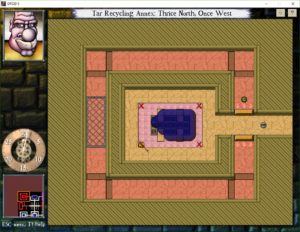The Second Sky: Stuck in Time
My earlier speculation is coming true: time travel and time-rewinding powers are becoming a more and more prominent part of both puzzle and plot. There’s an entire level, the Chronometric Sanctum, based around the same sort of accretive time-rewinding single-player-co-op puzzles as that one level of Braid, or P. B. Winterbottom, or Cursor x 10. Or a lot of other imitators. But never mind that it’s been done before. Combining it with DROD gameplay makes it new. One room uses trap doors to recreate the famous Seven Bridges of Königsberg problem, impossible in real life, easy when you have the help of your past self.
I say “an entire level”, but it’s really two levels: the same location in two time periods, which you can travel between via a larger version of the time-rewind tokens you use within the puzzles. There are rooms you can reach in both time periods, but they’re pristine and new in one period and overgrown ruins in the other, with crumbling walls and collapsed walkways and rusted-shut doors. I guess it’s an application of the King Dugan’s Dungeon Floor 6 pattern, reusing layouts while completely changing the puzzles.
I spent more time than I would have liked stuck here, and stuck in a way that’s unusual for DROD. I had cleared all the rooms on the level, but there didn’t seem to be a way forward. I just didn’t know where to go or what to do. I couldn’t even escape the way I came — as in the mines, the entrance seals behind you. The secret turned out to be that one room has a pressure plate hidden under one of the temporal split tokens. It’s a room where you don’t actually have to use the token otherwise, but it makes sense that it’s there anyway because it’s part of the puzzle in the room’s other version, in the other time period. The game UI helps you find the triggers for each door by highlighting them when you click on the door, but usually I use that to answer the question “Which of the various orbs and pressure plates I can see on this level controls the door?”. This is the first time I can think of that I needed to click on a door to see the controls at all.
After completing this section, the game starts linking levels together with time portals in the form of swirling vortices in the air. The first such portal sends you to the distant past, separating you from everyone and everything you’ve become familiar with through the story so far — except for the Critic, who still inexplicably manages to find you anyway.
In the wilderness that follows, you’re switched to another new weapon, the dagger. Like the spear, the dagger is a poking weapon. Unlike the spear, you can’t push things laterally with it. It doesn’t block monsters moving into its space, with the result that you can sometimes kill two in one blow: the one in the space it’s in, and the one in the space it moves to. But the most important thing about the dagger is that it lets you move like you’re unarmed. Moving in any direction automatically pivots you to face that way, whether you want to or not. This takes some getting used to, and reduces your capabilities somewhat. For example, it makes it impossible to push powder kegs around: pushing a thing means moving towards it, which automatically makes you face it, and moving towards a keg dagger-first means attacking it, which makes it explode.
The level that introduces the dagger does a peculiar thing: it contains features that are clearly meant for someone with a different weapon. One room has a red gate, which only opens when you’ve dropped all the trap doors in the room, but, just like when you’re unarmed, you don’t weigh enough to drop trap doors when you’re using the dagger. Another has a fuse and a set of powder kegs that could be pushed into a position to blast through a wall, if you could push them. It’s possible that this is just more trolling, but I suspect that this will all lead to revisiting the same rooms with a sword later, similar to the Chronometric Sanctum. Even before the time-travel stuff, there were some paired levels like that: The Easy Way and The Hard Way consisted of two versions of the same set of rooms.
I say that having gotten through the level. While getting through it, it seemed more likely that I’d get my sword back before leaving. Partly that’s because the very last room in the level has a very clear sword-only solution, and seems impossible with a dagger. It contains a small room filled with monsters on a ring of force arrows, isolated from where you can go. A potion nearby lets you drop a mimic inside the ring, where it could spin in place and kill everything if it had a weapon with an edge. It took me a good long time to figure that one out — it relies on a specific edge case in how mimics with daggers work. And, as in the Sanctum, I spent much of that time just wandering around the level, looking for I know not what.
 Comments(0)
Comments(0)
